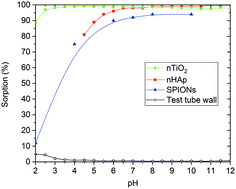Study of 223Ra uptake mechanism on hydroxyapatite and titanium dioxide nanoparticles as a function of pH
Abstract
The mechanism of 223Ra uptake on hydroxyapatite and titanium dioxide nanoparticles was studied as a function of pH. Both materials are widely used in food industry and medicine. They offer properties suitable for labelling with medicinal radionuclides, particularly for targeted radionuclide therapy. The selected isotope, 223Ra, is an alpha emitter widely used in targeted alpha particle therapy due to high-dose delivery in very small tissue volume, nevertheless the results are applicable for any radium isotope including 226Ra. The study was performed in the pH range 4.5 to 12 for hydroxyapatite nanoparticles and 2 to 12 for titanium dioxide nanoparticles in Britton–Robinson buffer solution. Both nanomaterials at pH 6 and higher showed that over 95% of the radium has been sorbed. According to the applied chemical equilibrium model, the most important species playing a role in sorption on the edge-sites were RaCO3, RaPO4−, RaHPO4 and Ra(Ac−)2, and Ra2+ and RaH2PO4+ on layer-sites. All experiments were conducted under free air conditions and no negative impact of CO2 was found. The surface complexation model was found suitable for describing radium uptake by the studied hydroxyapatite and titanium dioxide nanomaterials.



 Please wait while we load your content...
Please wait while we load your content...